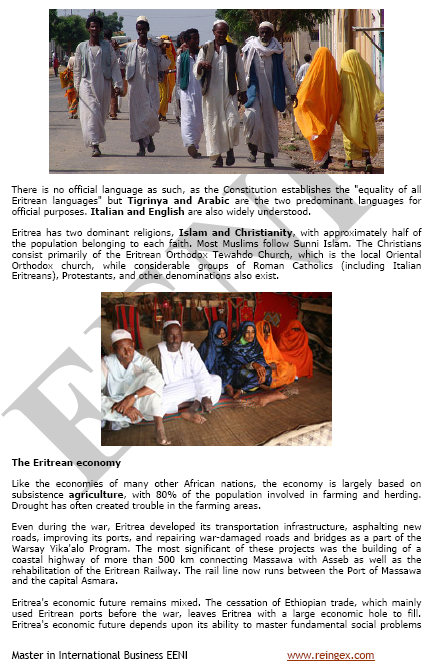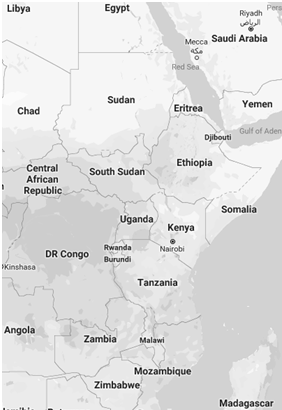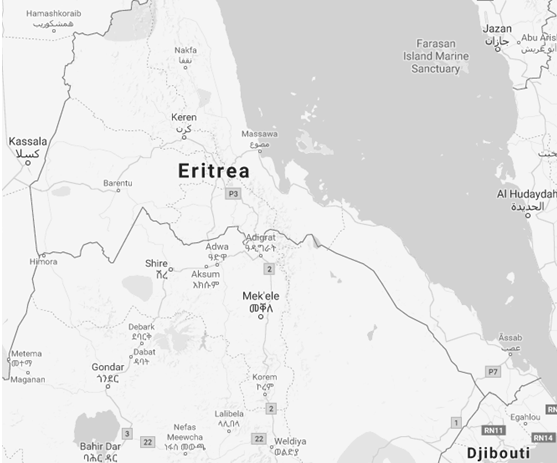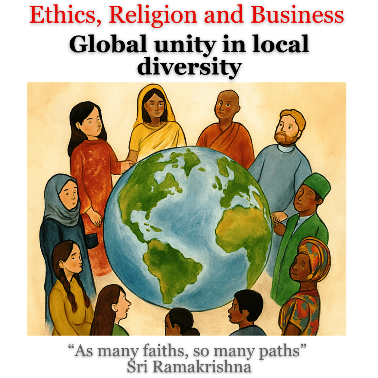Foreign Trade and Transport in Eritrea, Asmara, Tigrinya
Business in Eritrea, Asmara, Keren, Massawa, Assab. Tigrinya

Eritrea (State of Eritrea) is an East African country
- Eritrea:
- ሃገረ ኤርትራ in Tigrinya
- دولة إرتري in Arabic
- Erythra: Red Sea in Greek
- Asmara is the economic, political and administrative capital of Eritrea and the largest Eritrean city
- The largest cities of Eritrea are Asmara, Keren, Massawa, Assab, Mendefera, Barentu, Adi Keyh, Edd, Dekemhare and Ak'ordat
- The main Eritrean economic activity is agriculture
- The main Eritrean mineral resources are silver, gold, granite,
marble, copper and zinc
- Bisha: gold and silver mine
- Massawa: cement production
Transport and Logistics in Eritrea
- The most important ports of Eritrea are the Port of Massawa and Port of Assab
- Eritrea is located at the Horn of Africa (East Africa)
- Eritrea is surrounded to the north-east and east by the Red Sea
- Dahlak Archipelago is an archipelago on the Red Sea near Massawa, in Eritrea.
- Eritrea share borders with Djibouti, Ethiopia and Sudan (605 kilometres)
- The undefined border with Ethiopia is the main political problem of Eritrea
 Eritrean Students from Eritrea
Eritrean Students from Eritrea


More information: International Trade and Business in Eritrea, at EENI Global Business School.

- Eritrean population: 5 million people
- 1990: 3.2 million people
- Population density of Eritrea: 51.8 inhabitants / km²
- Area of Eritrea: 117,600 km²

- Eritrea is a unitary single-party presidential republic
- Eritrea obtained its Independence from Ethiopia in 1993
- History of Eritrea
- Calling code: 291
- Country code top-level domain: . er
- Currency of Eritrea: Nakfa (ERN)
Regions of Eritrea
The six regions of Eritrea are (in parentheses the capital):

- Maekel (Asmara)
- Sub-regions: Asmara, Berikh, Ghala-Nefhi, Semienawi Mibraq, Serejaka, Debubawi Mibraq, Semienawi Mi'erab, Debubawi Mi'erab
- Anseba (Keren)
- Sub-regions: Adi Tekelezan, Asmat, Elabered, Geleb, Hagaz, Halhal, Habero, Keren, Kerkebet, Sel'a
- Gash-Barka (Barentu)
- Sub-regions: Agordat, Barentu, Dghe, Forto, Gogne, Haykota, Logo-Anseba, Mensura, Mogolo, Molki, Guluj, Shambuko, Tesseney, The'elay Gash
- Debub (Mendefera)
- Sub-regions: Adi Keyh, Adi Quala, Areza, Debarwa, Dekemhare, Mai Ayni, Mai Mne, Mendefera, Segheneyti, Senafe, Tserona, Emni Haili
- Semien-Keih-Bahri (Massaoua)
- Sub-regions: Afabet, Dahlak, Ghel'alo, Foro, Ghinda, Karura, Massawa, Nakfa, She'eb
- Debub-Keih-Bahri (Assab)
- Sub-regions: Are'eta, Central Dankalia, Southern Dankalia, Assab

Trade and Business Organisations (Eritrea)
- Intergovernmental Authority on Development (IGAD)
- Common Market for Eastern and Southern Africa (COMESA)
- U.S.-COMESA Agreement
- COMESA-EAC-SADC Agreement
- Community of Sahel-Saharan States (CEN-SAD)
- African Development Bank
- African Union
- AUDA-NEPAD
- Economic Commission for Africa
Main Eritrean ethnicities:
Eritrea is a multi-ethnic country, with nine recognised ethnic groups
- Tigrinya represent 55% of the Eritrean population
- Tigre represent about 30% of the inhabitants.
- Other ethnic groups are Saho, Kunama, Bilen and Rashaida

Religions and Global Business -
Religious diversity
Religions in Eritrea:
- Orthodox Christianity (63% of the Eritrean population)
- Sunni Islam (37%)
- African Traditional Religions
Languages of Eritrea
Eritrea does not have an official language (concept of «equality of all the Eritrean languages»)
- Tigrinya (2.5 million) is the most spoken language
- Working and business languages are Tigrinya, Arabic and English
- Italian is taught in primary and secondary schools
Higher Education in Eritrea
- University of Asmara
- Institute of Technology of Eritrea


 Tweet
Tweet

